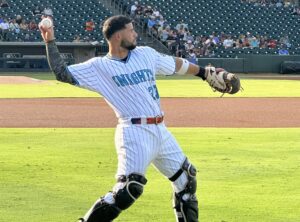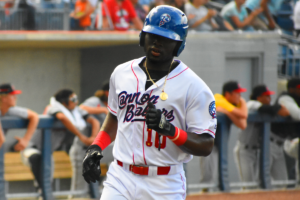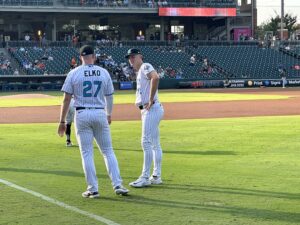Q and A with Charlotte Knights Pitching Coach Matt Zaleski
Entering his fifth season as a White Sox minor league coach, Matt Zaleski prepares to take on his highest profile challenge yet — as pitching coach for the Charlotte Knights. Zaleski sat down with Jeff Cohen of FutureSox just two days before heading out to the White Sox training complex in Arizona to share his insights on his role in developing minor league pitchers.
By his own admission, Zaleski, 38, did not have major league talent as a player. “I got outs,” he said, “but I did not have the stuff to be at the major league level.” Drafted in the 30th round of the 2004 Amateur Draft, the Arlington Heights, Illinois native spent nine years in the White Sox minor league system. He never got the call-up to Chicago.
“I had the belief in myself that I could pitch in the big leagues,” he said. “Talent-wise I didn’t have a ton of stuff. I tried to read hitters’ swings, out-smart them. We didn’t have the data back then so you just had to figure a lot of it out yourself.”
Today, of course, the White Sox utilize a TrackMan radar system at its minor league affiliates to measure the location, velocity and spin rate of pitched balls. “We look at the numbers every day,” Zaleski noted. “It is a part of the game. And it is a phenomenal tool for these kids.”
It will be Zaleski’s challenge to analyze the data and determine how to translate it into improved, repeatable performance by the Knights pitching staff. But the White Sox are likely also betting that Zaleski can go one step further, imparting the drive, savviness and mental toughness that he demonstrated as a minor league pitcher to the young Knights’ staff.
The White Sox’ confidence in Zaleski is apparent. Upon conclusion of his baseball playing days, he joined the team’s Great Falls (Rookie) affiliate in 2016 as pitching coach. Last season, he was named to the same position with Winston-Salem (High-A). And this season, of course, they are entrusting him to send them major league-ready ballplayers.
How valuable are the analytics?
It is incredible. You can see how a pitcher’s stuff will produce at the major league level. You can get an idea on what kind of a development path a guy needs. It could be on a fast track, it could be that this guy need to add a breaking ball, or something along those lines.
What else do you look for in the data?
If someone is a hard-throwing guy, I’ll look at the movement of his pitches. If they are more pitchability guys, I’ll look at the opposing team’s contact. Is it hard contact? Is it weak contact?
As the roster takes shape, what kind of planning will you do? What kind of direction will you get from the White Sox?
Each guy has his own development plan. That’s for our farm director, Chris Getz, those guys to sit down and decide. That will be a discussion we will have in Spring Training. The White Sox do a good job of communicating with us and the other coordinators to have a unified voice on what they’re looking for in pitching, deliveries and all that stuff.
As part of those developmental plans, do the White Sox do anything in particular to minimize the risk of injury to pitchers?
Monitoring their workloads is the biggest thing. Obviously, when it is late in the season, we’ll back off their bullpen sessions. Maybe a starter had a couple of long starts in a row, maybe after two seven-inning, 100-pitch starts, we’ll get them at five-inning, 75-pitches. Just taper back a bit to take the stress off the arm a little bit.
As pitching coaches, we monitor deliveries, always trying to clean things up, and if we see something that doesn’t look right, it is a red flag that we have to address before he gets back on the mound.
What’s the biggest difference between A and AAA ball?
The pitchers and hitters have a much better idea of what they want to do at the plate and on the mound in AAA.
These guys that are going to be in Charlotte are so close to the big leagues — some of them have probably already been up there at some point — it is just a matter of improving that consistency, either pitch location or repeatability of their delivery, to allow them to continue the success that got them to AAA.
What do you like most about being a pitching coach?
I liked best seeing the pitchers get better. Some of them may see small changes to their stuff over a week or two, but it is the guys who are there the whole year or maybe half a year and their progression is just a little slower than other guys, and they may not see it, but I can see the progression, and that’s the beautiful part of coaching. You have 13 guys who you are helping get better, and you see them working hard every day and improving.
How easy is it to spot major league talent in the minor leagues?
You can tell if they have the tools to be a major leaguer pretty quickly. You can see it in bullpen work, the way the ball is jumping out of a pitcher’s hand, the way it breaks on off-speed stuff, if they have the tools to be a major leaguer, and then after that it comes down to command and all that other stuff.
But some guys, though, take a while to figure it out?
Absolutely. That’s the beautiful part of coaching. There are development stages and each level is different. As a coach, you have to get the player to the next level and that next development stage. They are always going to be learning, even guys in the major leagues.
You never are a finished product. Even guys who are MLB All-Stars. You always want to get better. Look at Gerrit Cole. I don’t know Gerrit Cole but I’m sure he’d tell you that he wants to improve something.
A scout once told me that he looks for three things in a ballplayer — athletic ability, baseball skills and make-up. Guys are going to fail, but it is the guys who have the drive and perseverance to battle through the hard times who succeed. How important is a pitcher’s mental toughness?
It can make or break a guy. I’m sure there’s been tons of guys who had great stuff and terrible make-up and you don’t ever see them crack the big leagues.
If I’m a scout and a guy has lights-out stuff, but then you see him shove one of his teammates in the dugout, and then you hear from another scout that he’s got bad make-up, the next thing you know this guy with tremendous stuff loses out on a couple of opportunities.
How critical is velocity to being a big league pitcher?
Very big. Very, very big. Being a guy who threw 86-90, it kind of hurts to say — and there’s still a place for guys who can get outs — but velocity can make up for a lot of other things.
A couple of Winston-Salem pitchers credit you for helping them add velocity. How much velocity can you add through improved technique?
Velocity? That’s probably just luck. Maybe I just gave them a little adrenaline shot that night. (laughing) I don’t think changing a delivery can increase a lot of velocity. Maybe one to two miles an hour.
It is more about keeping pitches cleaner and tighter. If you are able to clean up the delivery, get a pitcher into a batter’s back leg a little more, whatever we’re talking about with the individual player that will clean up his stuff, so maybe his fastball doesn’t leak over the plate, or maybe tighten up his breaking ball.
Major league baseball introduced the “juiced” ball into AAA last year. How will it change what you do if the same ball is used again this year?
What we’re trying to do as coaches is provide as much information to these players as possible, so they can get swings and misses and weak contact and, yes, the ball and the ballpark does matter, but the more often you can get swings and misses and weak contact, the ball and ballpark doesn’t matter.
The mistakes are just louder?
Yes.
Who is the best pitcher you ever saw in the minor leagues who didn’t have a major league career?
A friend of mine and former teammate, Brian Omogrosso, was incredible, he was a 97-100 miles per hour guy back before those guys were common, very good curveball, but ran into some injury problems and couldn’t bounce back.
Who are the biggest influences on you as a pitcher?
As far as big-league players, I’d say watching Greg Maddox. He had impeccable command. Just unbelievable command, and his ball moved a crazy amount.
Otherwise, it was probably my father and my two brothers. There were times — being in Winston-Salem as a pitcher for the third year in a row is not something you want to do — they’d tell me to make them take the jersey off of you, and I’d step back and think, yeah, I get to go to work and put on a jersey for a living.
Want to know right away when we publish a new article? Type your email address in the box on the right-side bar (or at the bottom, if on a mobile device) and click the “Subscribe” button. Our list is completely spam free, and you can opt out at any time. Also, consider supporting FutureSox on Patreon! You can get early access to special articles and Patreon-only posts, in addition to more benefits you can read about here. Shop our exclusive merchandise! Show your support with the latest FutureSox apparel.







Will I ever hear about Latin American players who get big bonuses and then lose their drive in baseball. They would rather take their money and go back home instead of grinding on the baseball field. I’m sure it happens but I’ve never heard any stories or names. Anyone want to name names?
It’s not that they lose their drive. Many of these guys agree to terms when they’re like 13 or 14 years old and play in showcases instead of games. Lots of guys just fail because baseball is very hard.
I always have thought that that’s what has happened to Rey Lopez. He grew up poor and he just lacks focus and determination on a consistent basis. He’s got ace stuff, pitches like an ace when he’s on but looks like crap most of the time.